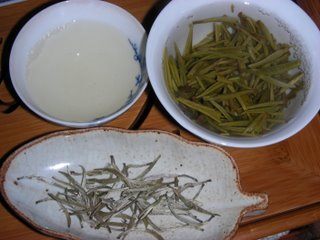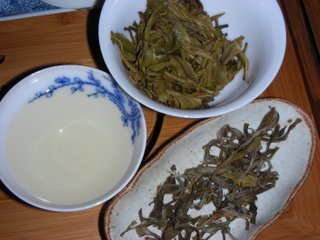Part of my loose leaves order arrived over the weekend. Inside of this box are mao fung, silver needle, sun dried bai mu dan, traditional bai mu dan and 10 kg of Lao Ban Zhang.

Sun Dried Bai Mu Dan
This is my favorite out of the 4 greens. Although I am not a big fan of green, this Bai Mu Dan has the floral aroma of a dan cong, sweetness of a pu-erh and the lightness of a green without the bitterness and grassiness.
4g, gaiwan, crab eye water, bottom throw
It started with a strong sweet floral aroma, liquid is clear yellow, sweet, a lot of flavor for a green. Being sun dried, it should be categorized as white instead of green?! Well, it has all the characteristics of white, no much of green at all. It can take long steeping and hot or warm water, taste great hot or warm. The flavor does not turn bland in anyway. It's a great tea for beginners and every day office drink. You can't make a bad cuppa with this tea no matter what tool you use. Well with the exception of bad tap water maybe. Love it! A good skilless tea.

Silver needles
Attractive looking leaves, young and hairy, though not as hairy as some others I have seen. It's also on the thin side.
4g, gaiwan, crab eye, bottom throw
It was nutty and grassy, astringent, very light yellowish color, sweet after taste, dry mouth feel afterwards, can't take long infusions. It's decent, but nothing to brag about.

Jade pole
interesting looking tea, my first perception was these might be some old leaves. Turns out they are very young and tender, long thin leaves picked right after spring rain.
4 poles (4g), gaiwan, crab eye, bottom throw
Sweet and nutty, a bit astringent, slight sweetness, last 3 brews, faded quickly after the second. Its flavor is better than the silver needles.
I had 3 out of 4 greens so far for the day, and already drunk. But, I am going to hit one more - traditional bai mu dan.

Traditional bai mu dan
This is a true green version, steamed then dried.
4g, gaiwan, crab eye, bottom throw
Light floral, grassy, hint of nutty and astringency, sweet and nutty after taste, last 3 brews, mild in every way as a typical green. Bitter and astringent when steeped for long.

Difference of the 2 bai mu dan
Left: traditional (steamed green); right: sun dried (fermented during drying). Sun dried version is very flavorful compared to the steamed version. The fermentation allowed the break down of the sugar, gave it a honey like sweetness brew after brew. This is my re-orderable item.







